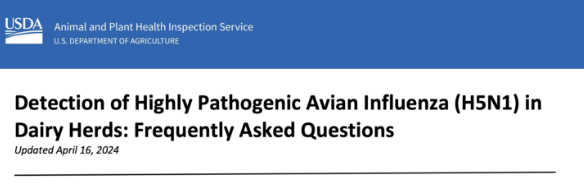The progressive spread of a highly infectious strain of avian flu virus infections to more mammal species is a concern to scientists, public health officials, and farmers. However, the publicly released genomic data do not include critical information on the outbreak’s origins and evolution.

Four months ago, we wrote about the surge of the H5N1 bird flu strain that had by then already killed tens of millions of birds in various parts of the U.S. and land and marine animals in the U.S. and other countries. Since then, the avian flu has jumped to cows and goats, surprising experts. It has been reported in 34 herds of dairy cows in nine states, but the outbreak is unquestionably much more extensive than that; fragments of bird flu virus genomic RNA have been detected in more than 20 percent of retail milk samples tested in a nationally representative study. Also, recently released viral sequences from animal infections provided by USDA indicate that the outbreak likely began in December 2023, with a single spillover incident from birds into cows.
Although these findings surprised health officials, they say there is at present little concern that milk containing infectious virus will make it into the food supply. Dairies must destroy milk from sick cows, and pasteurization is believed to kill the virus in milk from infected cows that have not yet been identified as ill. Sensitive tests have not detected infectious virus in milk, but federal officials are advising not to drink raw milk or eat raw milk-based cheese.
A worrisome development is that a man working on a Texas dairy farm was diagnosed with illness from the avian flu strain, presumably from contact with an infected cow. It is only the second known case in the U.S. of a human contracting avian flu.
H5N1 avian flu lethal in humans
Infections by the current virus strain have been increasing since the 1990s as the world poultry population soared to meet escalating food demand. H5N1 avian flu claimed its first known human victims in 1996-97 in China and Hong Kong, spread to Cambodia in 2003, and then reappeared with a vengeance a decade ago.
According to the WHO, most of the H5N1 infections and deaths occurred in Egypt, Vietnam, and Indonesia.
We wrote in January:
Despite limited examples of person-to-person transmission, there are no known examples of widespread, sustained transmission among humans or any mammals for that matter. However, virus evolution called “antigenic shift” could give rise to the emergence of novel viral subtypes able to target mammals.
As often happens in the infectious disease world, circumstances have changed dramatically in just a few months. The discovery of H5N1 bird flu in dozens of herds of dairy cows across the U.S. has sparked worry and a call for more transparency from the government — specifically, the USDA. While this strain of bird flu is not new, it had never before been found in cattle. It has now affected herds in at least eight states, with some cows showing reduced milk production and discolored, viscous milk.
Scientists and public health experts are particularly concerned about the virus spreading more widely in cows and mutating to readily infect humans.
Transparency concerns
Many experts have criticized the USDA for not being more forthcoming with information about the outbreak. Their concerns include:
- How is the virus spreading between cow herds — through cattle movement, contaminated feed or milking machines, or wild birds?
- Whether the outbreaks in different herds are connected. Are they all linked to a single source in Texas, or are there independent outbreaks happening – perhaps via a new strain of H5N1 in wild birds?
- The effect of pasteurization on H5N1. Farmers are being told to discard milk from infected cows, although the USDA, the FDA, and the CDC all say they believe pasteurization would kill the viruses. However, that is based on work previously done on other pathogens.
This lack of transparency is hindering the science community’s efforts to understand the outbreak and develop effective control measures. Michael Osterholm, the director of the Center for Infectious Disease Research and Policy at the University of Minnesota Medical School, argues that clear communication is crucial for managing outbreaks successfully:
[Government officials] are creating the perception that something is happening or not happening that would not meet with the public’s approval. And this is really unfortunate. There’s no evidence here that there’s some kind of a smoking gun, that somebody did something wrong. Just tell us what you’re doing. And that’s not happening.
Risk of further spread
There is reason for grave concern if not (yet) panic. As we related in our January article:
The deadliest recent twist is the spread of H5N1 to mammals. Brazil recently reported the deaths of more than 900 seals and sea lions, and thousands more were found dead last summer in Chile and Peru.
Washington State is on alert after dozens of seals showed up dead off the Olympic peninsula, alarming scientists. H5N1 has also infected large numbers of foxes, raccoons, skunks, grizzly bears and dolphins. Local authorities in all of these areas are scrambling to contain its spread, and warning humans not to touch the dead animals.
The H5N1 virus has the potential to mutate and increase its host range further. During the past few months, Texas reported its detection in cats from several dairy farms experiencing H5N1 outbreaks in cows. It is unknown whether the virus spread to the cats from affected dairy cows, raw cow milk, or wild birds associated with those farms.
Public health authorities are concerned that the virus could mutate and become capable of human-to-human transmission, which would be disastrous since it has a reported case-fatality rate of over 50% in humans. And although the true case-fatality rate may be significantly lower than that because of the presence of asymptomatic infections, it is noteworthy that during the calamitous 1918 Spanish flu pandemic, the case-fatality rate was only about 2%.
Another concern is that pigs, which can be infected by avian and human flu, could be infected simultaneously (coinfected) by pig and human viruses. That could lead to the reassortment of segments of RNA that comprise the flu virus genome and give rise to a new strain that is more transmissible to people.
Looking for answers
USDA’s frequently asked questions document, posted on its website, offers much information about what is currently known, recommended, or underway. It includes the following:
- "Tests so far indicate that the virus detected in dairy cows is …the same clade [i.e., variant] that has been affecting wild birds and commercial poultry flocks and has caused sporadic infections in several species of wild mammals, and neonatal goats in one herd in the United States.”
- "The spread of the H5N1 virus within and among herds indicates that bovine to bovine spread occurs, likely through mechanical means. As a result, we are encouraging producers and veterinarians to minimize dairy cattle movement.”
- "Unlike in poultry flocks where H5N1 is fatal, among the dairies whose herds are exhibiting symptoms, the affected animals have recovered with little to no associated mortality reported.”
- "Based on information available at this point [April 16], we do not anticipate that this [outbreak] will impact the availability or the price of milk or other dairy products for consumers.”
- "Recent detections of H5N1 in poultry have slowed. As of April 15, 2024, there have been 26 detections of H5N1 in commercial poultry facilities in 2024, which is like the number in January-April of 2023 (19 detections). Both years are showing significant decreases in the number of detections compared to 2022, when we saw 165 detections in the January-April period.”
- "At this stage, we do not anticipate the need to depopulate [i.e., cull] dairy herds. Unlike HPAI (H5N1) in birds which is typically fatal, little to no mortality has been reported and the animals are reportedly recovering. The affected cows on the dairy farms are currently being isolated from other animals.”
- It is noteworthy that avian flu has been detected only in dairy herds but not beef cow herds.
- "FDA’s longstanding position is that unpasteurized, raw milk can harbor dangerous microorganisms that can pose serious health risks to consumers, and FDA is reminding consumers of the risks associated with raw milk consumption in light of the H5N1 detections.”
An important development would be the appointment of a prominent, knowledgeable government official as the point person for this rapidly developing situation, because the current precarious situation highlights the importance of the rapid accumulation and promulgation of information in managing outbreaks. USDA, CDC, and FDA’s sharing of information freely and quickly would allow scientists, public health officials, and farmers to work together to assess and reduce risks. However, up to now, the publicly released data do not include critical information on the outbreak’s origins and evolution. “In an outbreak response, the faster you get data, the sooner you can act,” says genomic epidemiologist Martha Nelson. “Whether we’re not too late, to me, that’s kind of the million dollar question.”
An earlier version of this article was published by the Genetic Literacy Project.
Henry I. Miller, a physician and molecular biologist, is the Glenn Swogger Distinguished Fellow at the American Council on Science and Health. He was the founding director of the FDA’s Office of Biotechnology. Find Henry on X @HenryIMiller
Kathleen L. Hefferon is an instructor in microbiology at Cornell University. Find her on X @KHefferon

